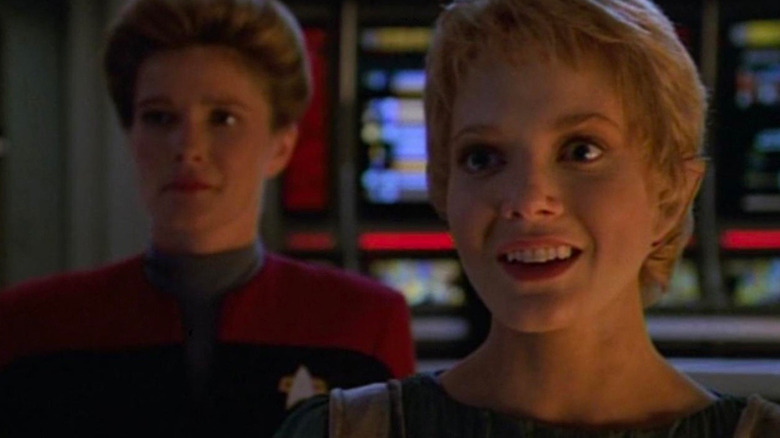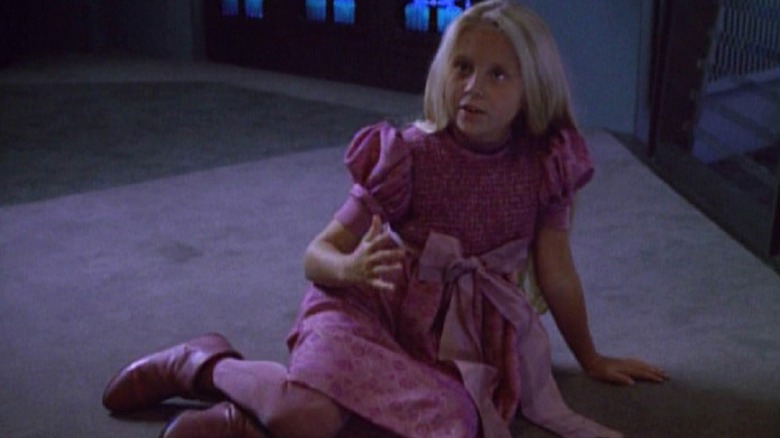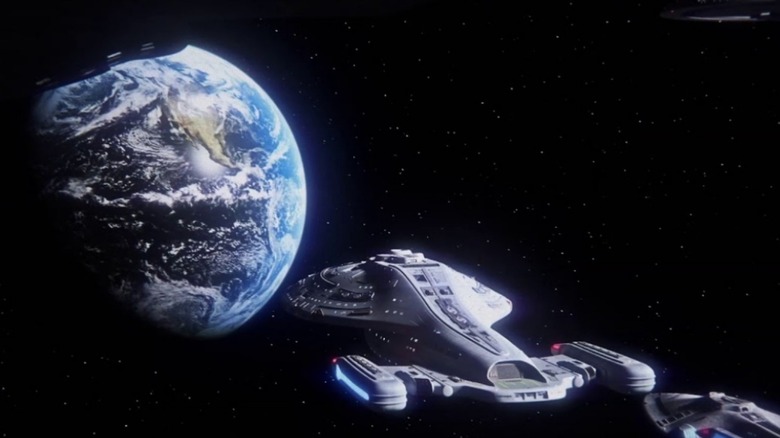Star Trek: Voyager's Get Out Of Jail Free Card: Suspiria Explained
Being a "Star Trek" fan is a full-time job unlike any other. While normal people would find hundreds of hours of material a daunting prospect, the average Trekkie has been dutifully conditioned to say things like, "Don't worry, this overall mediocre show finally gets good in season 4" or staunchly defend some of the absolute weirdest and most out-there concepts ever produced in live action. (I have three words for you: baby Clint Howard. Actually, make that another three: killer ooze monster.)
"Star Trek: Voyager" had plenty of highlights and lowlights in that regard, from that time Captain Katherine Janeway (Kate Mulgrew) and Lieutenant Tom Paris (Robert Duncan McNeill) hooked up with each other after devolving into lizards – yes, this really happened – to the horrifying legacy of "Tuvix." But none of it would've been possible had Paramount Television failed to support the production that would become "Voyager" back in its earliest conception. While "Deep Space Nine" gets all the credit for radically reinventing the very idea of what "Trek" could be, it was "Voyager" that pushed boundaries a few years later by virtue of its premise of a Starfleet ship hopelessly stranded in the farthest reaches of a distant quadrant of the galaxy. A far cry from the franchise's mission statement of optimistic exploration within a very defined and downright utopian framework, this upstart new series seemed even more sacrilegious than setting an entire show on a space station.
So, in order to sell a very skeptical decision-maker on the potential of "Voyager," creators Rick Berman, Michael Piller, and Jeri Taylor came up with a compromise. They'd build an escape plan right into the pilot episode, a "Break glass in case of emergency" scenario should low ratings dictate a creative overhaul. That, however, was only the beginning.
Plan B
Sometimes, writers strike gold with a brilliant pitch that sets the stage for a vastly compelling and hopefully long-lasting series — it's when figuring out the details that things get tricky. For "Star Trek: Voyager" co-creators Rick Berman, Michael Piller, and Jeri Taylor, they had the unenviable task of convincing Paramount Television President Kerry McCluggage that they weren't completely bending the "Trek" ethos until it broke. Despite the apparent bleakness of having a crew cut off from everyone they know back home and flinging them into the cold, unknown depths of space with zero support system other than themselves, the "Trek" veterans knew that they could pull off another hopeful, idealistic series.
That required some brainstorming, however, as they attempted to balance the strength of their original pitch — arguably one of the most exciting starting points of any "Trek" show, in which a cosmic entity known as the Caretaker (taking the form of an elderly human, portrayed by Basil Langton) abducts the USS Voyager and transports them 70,000 light years away — with the need to adjust on the fly. Their solution was to reference a second ancient lifeform named Suspiria, in the form of a young girl (Lindsay Ridgeway), and use her as a potential backup plan to get the crew home again much quicker. In author Stephen Edward Poe's 1998 novel "A Vision of the Future – Star Trek: Voyager," Berman explained their reasoning:
"Frankly we made a concession to finally finish the sales job ... the other entity that we met in the pilot. It's out there somewhere. We will try to find that entity and contact that entity more than once during the next several years because we know that the entity has the ability to send us back home."
The backup to the backup plan
If at any point "Star Trek: Voyager" began to suffer from flagging ratings and audience impatience regarding the crew's circumstances, the writing team would've had to pull the trigger on Suspiria. This didn't end up becoming necessary as the writers were given a longer runway to let "Voyager" play out, allowing them to flesh out and subsequently deal with Suspiria in the season 2 episode "Cold Fire." Still, the Voyager crew were nowhere closer to home.
Enter the idea of our heroes stumbling upon a wormhole, one that could transport them all the way back to Earth. While a simple solution to a series-long problem, this would've also resulted in the show's transformation into something much less thrilling. For his part, Michael Piller was against this all along. In "A Vision of the Future," he explained:
"I'd be very disappointed if that happened ... that would rob the freshness of the show. It would turn into a very traditional, straight-ahead-to-the-original Star Trek show. There's an emotional investment that comes with being away from home under those circumstances...the impact that it makes on every person on that ship. They suddenly realize they may never see their home again, their loved ones again. The stakes, the investment they have in trying to get home again. It's a very strong motivational underpinning of the series."
Jeri Taylor agreed, although she used this potential "Get out of jail free" card as motivation: "I think you need to keep that sort of nervous energy going creatively, saying to yourself, 'No, I don't have an easy way out. I have to keep coming up with ways to make this intriguing and interesting.'" Ultimately, the writers returned Voyager to Earth without any of these "outs." But who knows what could've been?


